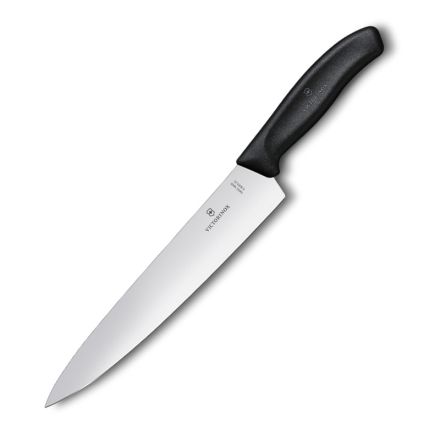The world of kitchen knives is constantly evolving, with new trends emerging that cater to both professional chefs and home cooks. Let’s dive into what’s currently hot and what’s not in the realm of kitchen knives, focusing on Victorinox knives, butcher’s knives, and kitchen knives in the UK.
What’s Hot
Victorinox Knives
- Versatility and Quality. Victorinox knives continue to be a favourite among UK chefs and home cooks alike. Known for their Swiss precision and durability, these knives are versatile and suitable for a wide range of kitchen tasks.
- Innovative Designs. The brand has introduced new designs that combine traditional craftsmanship with modern aesthetics. For example, the Swiss Modern collection features sleek, synthetic handles that are both stylish and practical.
- Victorinox is also focusing on sustainability, using eco-friendly materials and processes in their knife production.
Butcher’s Knives
- Specialised Blades. There is a growing trend towards specialised butcher’s knives designed for specific tasks such as breaking down large cuts of meat, trimming fat, and filleting fish. These knives are crafted to provide precision and efficiency.
- High-Carbon Steel. Butcher’s knives made from high-carbon steel are gaining popularity due to their superior edge retention and sharpness. Brands like Dalstrong and Mercer Culinary are leading the way with their high-quality butcher’s knives.
- Ergonomic Handles. Comfort and safety are paramount, and many butcher’s knives now feature ergonomic handles that reduce hand fatigue and provide a secure grip.
Kitchen Knives in the UK
- Japanese Influence. Japanese-style knives, such as Santoku and Nakiri, are becoming increasingly popular in the UK. These knives are known for their lightweight design, sharp edges, and precision cutting.
- Knife Sets. Consumers are opting for comprehensive knife sets that include a variety of blades for different tasks. Brands like Wüsthof and Zwilling offer high-quality sets that cater to both beginners and experienced cooks.
- Aesthetic Appeal. There is a trend towards aesthetically pleasing knives that not only perform well but also look good in the kitchen. Damascus steel knives with intricate patterns and wooden handles are particularly sought after.
What’s Not
Low-Quality Stainless Steel Knives
- Poor Edge Retention. Knives made from low-quality stainless steel are falling out of favour due to their inability to maintain a sharp edge. Consumers are now more informed and willing to invest in higher-quality materials.
- Lack of Durability. These knives often lack the durability needed for regular use, leading to frequent replacements and dissatisfaction.
Single-Purpose Knives
- Limited Use. Single-purpose knives that are only suitable for one type of task are becoming less popular. Home cooks and chefs prefer versatile knives that can handle multiple tasks, reducing the need for numerous specialised tools.
Bulky Knife Blocks
- Space Constraints. With kitchen space often at a premium, bulky knife blocks are being replaced by more compact and efficient storage solutions, such as magnetic strips and in-drawer organisers.
Victorinox: History and Product Range
History of Victorinox
Victorinox, a name synonymous with quality and precision, was founded in 1884 by Karl Elsener in Ibach, Switzerland. Initially a small cutler’s workshop, the company gained international fame with the creation of the Swiss Army Knife in 1897. This iconic tool became a symbol of Swiss craftsmanship and ingenuity. Over the years, Victorinox has expanded its product range and now operates in over 120 countries, offering a diverse array of high-quality products.
Types of Victorinox Knives
- Chef’s Knives. These are essential for a variety of kitchen tasks, from chopping vegetables to slicing meat. Victorinox chef’s knives are known for their ergonomic handles and balanced design, making them a favourite among chefs and home cooks alike.
- Butcher’s Knives. Designed for heavy-duty tasks, these knives are perfect for breaking down large cuts of meat. They feature robust blades and comfortable handles, ensuring precision and ease of use.
- Kitchen Knives. Victorinox offers a wide range of kitchen knives, including paring knives, bread knives, and carving knives. Each knife is crafted to provide excellent performance and longevity.
Tools, Accessories, and Machinery for the Food Processing Industry
- Cutting Tools. In addition to their renowned knives, Victorinox offers specialised cutting tools such as boning knives, filleting knives, and cleavers. These tools are engineered to provide precise cuts and withstand heavy use.
- Victorinox provides a range of accessories to complement their knives, including knife sharpeners, protective sheaths, and storage solutions. These accessories help maintain the sharpness and safety of the knives.
- For large-scale food processing, Victorinox offers machinery such as meat slicers and grinders. These machines are built to handle high volumes of food with efficiency and precision.
The Future of Kitchen Knives in the UK
The current trends in kitchen knives emphasise quality, versatility, and aesthetic appeal. Brands like Victorinox continue to innovate while specialised butcher’s knives and Japanese-style blades gain popularity. Consumers are moving away from low-quality materials and single-purpose tools, opting instead for durable, multi-functional knives that enhance their culinary experience.


